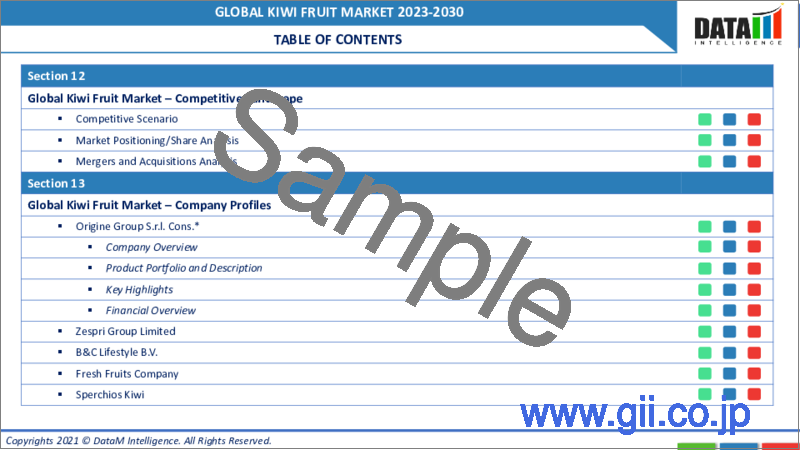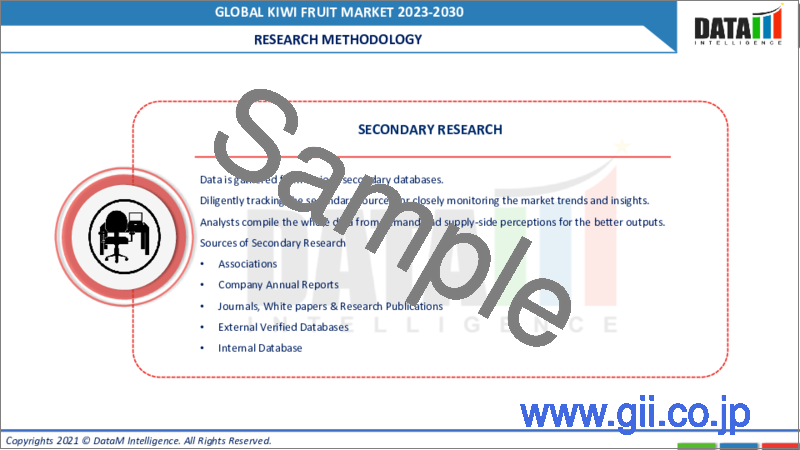|
|
市場調査レポート
商品コード
1319174
キウイフルーツの世界市場-2023年~2030年Global Kiwi Fruit Market - 2023-2030 |
||||||
カスタマイズ可能
適宜更新あり
|
|||||||
| キウイフルーツの世界市場-2023年~2030年 |
|
出版日: 2023年07月31日
発行: DataM Intelligence
ページ情報: 英文 150 Pages
納期: 即日から翌営業日
|
- 全表示
- 概要
- 目次
市場概要
世界のキウイフルーツ市場は、2022年に15億米ドルに達し、2030年には21億米ドルに達すると予測され、予測期間2023-2030年のCAGRは4.8%で成長すると予測されています。キウイフルーツの健康的な摂取と健康効果に対する人々の意識の高まりが、世界のキウイフルーツ市場規模を拡大しています。
消費者は栄養価の高い製品を好むため、企業はこれを潜在的な顧客拡大戦略と考えています。キウイフルーツを重要な成分として使用した新製品が発売され、市場の需要を高めています。キウイフルーツはキャンディー、ジャム、アイスクリーム、ソースなど多くの製品に使用されています。例えば、2022年3月、クラフト飲料市場向けのフルーツピューレを製造するオレゴン・フルーツ・プロダクツLLCは、季節限定の最新作「キウイピューレ」を発表しました。
米国食品医薬品局は、キウイフルーツの栄養成分について、低脂肪、飽和脂肪無添加、ナトリウム無添加、コレステロール無添加、高繊維質、高ビタミンC、良質なビタミンE源、良質なカリウム源であることを承認しています。人々の間で健康効果に対する意識が高まっていることが、キウイフルーツ市場の需要を大規模に押し上げました。
市場力学
キウイフルーツに対する需要の高まりがキウイフルーツ市場の成長を牽引すると推定されます
消費者はビーガンライフスタイルをますます受け入れ、健康的な食品を選ぶようになっています。果物は常に、より重要な栄養源です。米国農務省が提供する栄養情報によると、キウイ・フルーツはビタミンC、食物繊維、カリウムの優れた供給源です。他の果物に比べ、キウイは糖分が低く、食物繊維が豊富です。そのため、世界の消費者から絶大な需要があります。
キウイ1個で1日のビタミンC摂取量の117%、食物繊維の21%を摂取できます。キウイフルーツのビタミンC含有量は、オレンジやレモンの2倍です。この果物は心臓と消化器の健康をサポートし、腸の健康を維持し、抗酸化力を提供し、免疫力を向上させる。このように、キウイフルーツの効能の増加は、キウイフルーツ市場の需要拡大につながります。
新品種と製品発売が市場成長を牽引しています
Plant &Food Research社とZespri社は、キウイフルーツ育種センターを設立するために新たなジョイントベンチャーを立ち上げました。このセンターはテ・プケを拠点とし、キウイフルーツの育種において、より健康的で、より美味しく、より持続可能性に重点を置いた品種の創出に焦点を当て、より素晴らしいイノベーションを推進することを目的としています。キウイフルーツの発明はどんどん増えており、そのひとつがレッド・キウイフルーツのイントロダクションです。爽やかなラズベリー味は市場試験で成功を収め、2020年にはニュージーランドで最初の果実の商業化が行われました。
飲食品業界におけるキウイフルーツの用途拡大も市場規模を押し上げます。これらの果実は、キャンディー、ジャム、アイスクリーム、ソースなどの新製品に使用されています。例えば、2022年3月、クラフト飲料市場向けフルーツピューレのメーカーであるOregon Fruit Products LLCは、最新の季節リリースであるキウイピューレを発表しました。
包装分野でも新たな動きがあります。ゼスプリは、世界の大手ブランドとともに、プラスチックの循環型経済を目指すエレン・マッカーサー財団の「New Plastics Economy Global Commitment」に署名しました。2025年までにすべての包装を100%再利用可能、リサイクル可能、または堆肥化可能にすることがゼスプリのコミットメントでした。
キウイフルーツが引き起こす低い賞味期限とアレルギーが市場成長を抑制します
キウイフルーツの賞味期限は比較的短いです。熟したキウイは冷蔵庫に入れても4週間以上はもたないです。キウイ・フルーツの取り扱いにおいては、その保存条件をより重視すべきです。高温は代謝プロセスを促進し、果実の保存性を低下させる。果実を長く保存するためには、望ましい温度と相対湿度の条件を維持する必要があります。
キウイ・フルーツは重要な食物アレルゲンとみなされるべきです。キウイは、特に幼児に重篤な反応を引き起こす可能性があります。その症状は、舌、唇、口のかゆみや不快感、目に見える皮疹といった軽いものから、呼吸困難やその他の喘息症状、腹痛、めまい、嘔吐といった重篤なアレルギー症状までさまざまです。国立衛生研究所によると、キウイアレルギーの有病率は全体で約13.3%です。
COVID-19影響分析
COVID-19分析には、COVID前シナリオ、COVIDシナリオ、COVID後シナリオに加え、価格力学(COVID前シナリオと比較したパンデミック中およびパンデミック後の価格変動を含む)、需給スペクトラム(取引制限、封鎖、およびその後の問題による需給の変化)、政府の取り組み(政府機関による市場、セクター、産業を活性化させる取り組み)、メーカーの戦略的取り組み(COVID問題を緩和するためにメーカーが行った取り組み)が含まれます。
目次
第1章 調査手法と調査範囲
第2章 市場の定義と概要
第3章 エグゼクティブサマリー
第4章 市場力学
- 市場への影響要因
- 促進要因
- 抑制要因
- 機会
- 影響分析
第5章 産業分析
- ポーターのファイブフォース分析
- サプライチェーン分析
- 価格分析
- 規制分析
第6章 COVID-19分析
第7章 タイプ別
- アクチニディア・デリシオサ
- アクチニディア・アルグータ
- アクチニディア・チネンシス
第8章 流通チャネル別
- スーパーマーケット
- 専門店
- コンビニエンスストア
- eコマース
- その他
第9章 地域別
- 北米
- 米国
- カナダ
- メキシコ
- 欧州
- ドイツ
- 英国
- フランス
- イタリア
- スペイン
- その他欧州
- 南米
- ブラジル
- アルゼンチン
- その他南米
- アジア太平洋
- 中国
- インド
- 日本
- オーストラリア
- その他アジア太平洋地域
- 中東・アフリカ
第10章 競合情勢
- 競合シナリオ
- 市況/シェア分析
- M&A分析
第11章 企業プロファイル
- Aongatete Coolstores Limited
- 会社概要
- 製品ポートフォリオと説明
- 財務概要
- 主な発展
- Mount Pack and Cool
- Aunckland Pack and Cool
- DMS Progrowers Limited
- Punchbowl
- Riverlock
- Eastpack Limited
- Seeka Kiwifruit Industries Limited
- Birchwood Packhouse Limited
- Apata Group Limited
第12章 付録
Market Overview
The Global Kiwi Fruit Market reached US$ 1.5 billion in 2022 and is expected to reach US$ 2.1 billion by 2030 and is expected to grow with a CAGR of 4.8% during the forecast period 2023-2030. The increased awareness about healthy intake and health benefits of kiwi fruit among people is increasing the global kiwi fruit market size.
Consumers prefer nutritional products; companies consider this a potential strategy to grow their customers. New products are launching with kiwi fruit as a significant ingredient, increasing the market demand. Kiwi fruits are used in many products, such as candies, jams, ice creams, and sauces. For instance, in March 2022, Oregon Fruit Products LLC, a manufacturer of fruit purees for the craft beverage market, announced its latest seasonal release, Kiwi Puree.
The U.S. Food and Drug Administration approved the nutrient content of kiwi fruit as low-fat, saturated fat-free, sodium-free, cholesterol-free, high in fiber, high in vitamin C, a good source of vitamin E, and a good source of potassium. The growing awareness of health benefits among the population boosted the demand for kiwi fruit market opportunities on a large scale.
Market Dynamics
The Growing Demand for Kiwi Fruit is Estimated to Drive the Kiwi Fruit Market Growth.
Consumers are increasingly embracing the vegan lifestyle and opting for healthy foods. Fruits are always a more significant source of nutrients. According to the nutrition information provided by the USDA, kiwi fruits are an excellent source of vitamin C, fiber, and potassium. Compared to other fruits, kiwis are naturally lower in sugar and higher in fiber. Therefore, this fruit is witnessing immense demand from global consumers.
One serving of kiwi fruit provides 117% of the daily vitamin C intake and 21% of dietary fiber. The vitamin C content in kiwifruit is twice that of oranges or lemons. This fruit can support heart and digestive health, maintain good gut health, provide antioxidant power, and improve immunity. Thus, the increased benefits of this fruit lead to more kiwi fruit market demand.
New Varieties and Product Launches are Driving the Market Growth.
Plant & Food Research and Zespri entered a new joint venture to establish the Kiwifruit Breeding Centre. The center is based in Te Puke, aiming to drive more incredible innovation within kiwifruit breeding, focusing on creating healthier, better tasting, and more sustainability-focused varieties. The invention of kiwifruit is growing; one such is the introduction of red kiwifruit varieties. The refreshing raspberry taste of the fruit was successful in market trials, and the first fruit commercial was done in New Zealand in 2020.
The increased application of kiwi fruit in the food and beverage industry also drives the market size. These fruits are used in new products such as candies, jams, ice creams, and sauces. For instance, In March 2022, Oregon Fruit Products LLC, a manufacturer of fruit purees for the craft beverage market, announced its latest seasonal release, Kiwi Puree.
There is a new development in the packing sector too. Globally, Zespri joined some of the world's biggest brands to sign up for the Ellen MacArthur Foundation's New Plastics Economy Global Commitment to create a circular economy for plastics. To make all packaging 100% reusable, recyclable, or compostable by 2025 was Zespri's commitment.
Low Shelf and Allergies Caused by Kiwi Fruit Restrains the Market Growth.
Kiwi fruit has a relatively minor shelf life. Kiwi that has ripened cannot last for more than four weeks in the refrigerator. The storage conditions of the fruit should be given greater importance in handling the kiwi fruit. High temperatures accelerate the metabolic processes and reduce the shelf life of the fruit. The desired temperature and relative humidity conditions needed to be maintained to secure the fruit for a longer time.
Kiwi fruit should be considered a significant food allergen. It is capable of causing severe reactions, particularly in young children. The symptoms can vary from mild itching or discomfort of the tongue, lips, or mouth and visible skin rashes to severe allergy conditions, where people can encounter difficulty breathing or other asthma symptoms, abdominal pain, dizziness, and vomiting. According to the National Institute of Health, the overall prevalence of kiwi allergy is about 13.3%.
COVID-19 Impact Analysis
The COVID-19 Analysis includes Pre-COVID Scenario, COVID Scenario and Post-COVID Scenario along with Pricing Dynamics (Including pricing change during and post-pandemic comparing it with pre-COVID scenarios), Demand-Supply Spectrum (Shift in demand and supply owing to trading restrictions, lockdown, and subsequent issues), Government Initiatives (Initiatives to revive market, sector or Industry by Government Bodies) and Manufacturers Strategic Initiatives (What manufacturers did to mitigate the COVID issues will be covered here).
Segment Analysis
The global kiwi fruit market is segmented based on type, distribution channel, and region.
In the Global Kiwi Fruit Market, the E-Commerce Segment Holds the Largest Market Share.
The global kiwi fruit market has been segmented by distribution channel into supermarkets, specialty retailers, convenience stores, e-commerce, and others. The e-commerce segment held the largest kiwi fruit market share of 38.8% in 2022 in the kiwi fruit market analysis report. The demand for kiwi is gaining traction worldwide, strengthened by consumers' growing concern for health and wellness.
People want to include these types of fruits in their daily diet. Because of their busy lifestyle and lack of time, they prefer online platforms to shop for their daily necessities. Apart from convenience and different brand availability, these online platforms also offer people attractive coupons, discounts, and even free shipping, making them more prevalent in all age groups.
Geographical Analysis
The Asia-Pacific Region Held the Largest Share of the Kiwi Fruit Market.
The global kiwi fruit market is segmented into five parts based on geography: North America, South America, Europe, Asia-Pacific, the Middle East, and Africa. The Asia-Pacific kiwi fruit market held the largest market share of 38.6% in 2022 in the kiwi fruit market analysis. Most people's health awareness increase is attributed to the growth of this region's kiwi fruit market.
There is a rise in kiwi fruit demand in China due to its health benefits and premium status. The vast market for kiwi fruit is encouraging a few well-known companies to invest in the kiwi fruit business. For instance, Dukang Distillers is a firm involved in making and selling baijiu. But, in 2021, the company changed its name to China Shenshen, stopped its operations of baijiu, and started its business in the kiwi sector. This type of development also boosted kiwi fruit market sales.
Competitive Landscape
The major global players in the market include: Aongatete Coolstores Limited, Mount Pack and Cool, Auckland Pack and Cool, DMS Progrowers Limited, Punchbowl, Riverlock, Eastpack Limited, Seeka Kiwifruit Industries Limited, Birchwood Packhouse Limited, and Apata Group Limited.
Global Recession/Ukraine-Russia War/COVID-19, and Artificial Intelligence Impact Analysis:
COVID-19 Impact:
The unprecedented COVID-19 pandemic in 2020 profoundly affected the food industry. COVID-19 has considerably impacted the food supply chain phases involving kiwi fruit production, processing, distribution, and consumption due to lockdowns and restrictions imposed by various governments.
Everything has changed due to the COVID-19 epidemic. It has influenced practically every industry, whether positively or negatively. The COVID-19 pandemic's effects on world economic conditions have had an influence. They could impact interest rates, foreign exchange rates, commodities and energy prices, and the efficient operation of financial and capital markets.
The COVID-19 pandemic issue has had an impact on the food industries as well. The COVID-19 pandemic is upending life, and the food sector is seeing an increase in trends like kiwi fruit. The food businesses are launching innovative programs, including kiwi fruit jams, ice cream, and others, which are readily available and straightforward to consume.
Why Purchase the Report?
- To visualize the global kiwi fruit market segmentation based on type, distribution channel, and region and understand key commercial assets and players.
- Identify commercial opportunities in the market by analyzing trends and co-development.
- Excel data sheet with numerous data points of kiwi fruit market level with all segments.
- The PDF report includes a comprehensive market analysis after exhaustive qualitative interviews and an in-depth market study.
- Product mapping is available as Excel consists of key products of all the major market players.
The Global Kiwi Fruit Market report would provide approximately 69 tables, 71 figures, and 150 pages.
Target Audience 2023
- Manufacturers/ Buyers
- Industry Investors/Investment Bankers
- Research Professionals
- Emerging Companies
Table of Contents
1. Methodology and Scope
- 1.1. Research Methodology
- 1.2. Research Objective and Scope of the Report
2. Market Definition and Overview
3. Executive Summary
- 3.1. Market Snippet, by Type
- 3.2. Market Snippet, by Distribution Channel
- 3.3. Market Snippet, by Region
4. Market Dynamics
- 4.1. Market Impacting Factors
- 4.1.1. Drivers
- 4.1.2. Restraints
- 4.1.3. Opportunity
- 4.1.4. Impact Analysis
5. Industry Analysis
- 5.1. Porter's Five Force Analysis
- 5.2. Supply Chain Analysis
- 5.3. Pricing Analysis
- 5.4. Regulatory Analysis
6. COVID-19 Analysis
- 6.1. Analysis of COVID-19 on the Market
- 6.1.1. Scenario Before COVID-19
- 6.1.2. Scenario During COVID-19
- 6.1.3. Scenario Post COVID-19
- 6.2. Pricing Dynamics Amid COVID-19
- 6.3. Demand-Supply Spectrum
- 6.4. Government Initiatives Related to the Market During the Pandemic
- 6.5. Manufacturers Strategic Initiatives
- 6.6. Conclusion
7. By Type
- 7.1. Introduction
- 7.1.1. Market Size Analysis and Y-o-Y Growth Analysis (%), By Type
- 7.1.2. Market Attractiveness Index, By Type
- 7.2. Actinidia deliciosa
- 7.2.1. Introduction
- 7.2.2. Market Size Analysis and Y-o-Y Growth Analysis (%)
- 7.3. Actinidia arguta
- 7.4. Actinidia chinensis
8. By Distribution Channel
- 8.1. Introduction
- 8.1.1. Market Size Analysis and Y-o-Y Growth Analysis (%), By Distribution Channel
- 8.1.2. Market Attractiveness Index, By Distribution Channel
- 8.2. Supermarkets
- 8.2.1. Introduction
- 8.2.2. Market Size Analysis and Y-o-Y Growth Analysis (%)
- 8.3. Specialty Retailers
- 8.4. Convenience Stores
- 8.5. E-Commerce
- 8.6. Others
9. By Region
- 9.1. Introduction
- 9.1.1. Market Size Analysis and Y-o-Y Growth Analysis (%), By Region
- 9.1.2. Market Attractiveness Index, By Region
- 9.2. North America
- 9.2.1. Introduction
- 9.2.2. Key Region-Specific Dynamics
- 9.2.3. Market Size Analysis and Y-o-Y Growth Analysis (%), By Type
- 9.2.4. Market Size Analysis and Y-o-Y Growth Analysis (%), By Distribution Channel
- 9.2.5. Market Size Analysis and Y-o-Y Growth Analysis (%), By Country
- 9.2.5.1. The U.S.
- 9.2.5.2. Canada
- 9.2.5.3. Mexico
- 9.3. Europe
- 9.3.1. Introduction
- 9.3.2. Key Region-Specific Dynamics
- 9.3.3. Market Size Analysis and Y-o-Y Growth Analysis (%), By Type
- 9.3.4. Market Size Analysis and Y-o-Y Growth Analysis (%), By Distribution Channel
- 9.3.5. Market Size Analysis and Y-o-Y Growth Analysis (%), By Country
- 9.3.5.1. Germany
- 9.3.5.2. The U.K.
- 9.3.5.3. France
- 9.3.5.4. Italy
- 9.3.5.5. Spain
- 9.3.5.6. Rest of Europe
- 9.4. South America
- 9.4.1. Introduction
- 9.4.2. Key Region-Specific Dynamics
- 9.4.3. Market Size Analysis and Y-o-Y Growth Analysis (%), By Type
- 9.4.4. Market Size Analysis and Y-o-Y Growth Analysis (%), By Distribution Channel
- 9.4.5. Market Size Analysis and Y-o-Y Growth Analysis (%), By Country
- 9.4.5.1. Brazil
- 9.4.5.2. Argentina
- 9.4.5.3. Rest of South America
- 9.5. Asia-Pacific
- 9.5.1. Introduction
- 9.5.2. Key Region-Specific Dynamics
- 9.5.3. Market Size Analysis and Y-o-Y Growth Analysis (%), By Type
- 9.5.4. Market Size Analysis and Y-o-Y Growth Analysis (%), By Distribution Channel
- 9.5.5. Market Size Analysis and Y-o-Y Growth Analysis (%), By Country
- 9.5.5.1. China
- 9.5.5.2. India
- 9.5.5.3. Japan
- 9.5.5.4. Australia
- 9.5.5.5. Rest of Asia-Pacific
- 9.6. Middle East and Africa
- 9.6.1. Introduction
- 9.6.2. Key Region-Specific Dynamics
- 9.6.3. Market Size Analysis and Y-o-Y Growth Analysis (%), By Type
- 9.6.4. Market Size Analysis and Y-o-Y Growth Analysis (%), By Distribution Channel
10. Competitive Landscape
- 10.1. Competitive Scenario
- 10.2. Market Positioning/Share Analysis
- 10.3. Mergers and Acquisitions Analysis
11. Company Profiles
- 11.1. Aongatete Coolstores Limited
- 11.1.1. Company Overview
- 11.1.2. Product Portfolio and Description
- 11.1.3. Financial Overview
- 11.1.4. Key Developments
- 11.2. Mount Pack and Cool
- 11.3. Aunckland Pack and Cool
- 11.4. DMS Progrowers Limited
- 11.5. Punchbowl
- 11.6. Riverlock
- 11.7. Eastpack Limited
- 11.8. Seeka Kiwifruit Industries Limited
- 11.9. Birchwood Packhouse Limited
- 11.10. Apata Group Limited
LIST NOT EXHAUSTIVE
12. Appendix
- 12.1. About Us and Services
- 12.2. Contact Us






